Our featured influencer this month is Jen Pistor, who candidly (and beautifully) shares her everyday sustainable tips and tricks—and, quite frankly, inspires us to do better every time we catch her content. Read all about Jen below, and watch for more fabulous influencer insights in the coming months! —Vita Daily
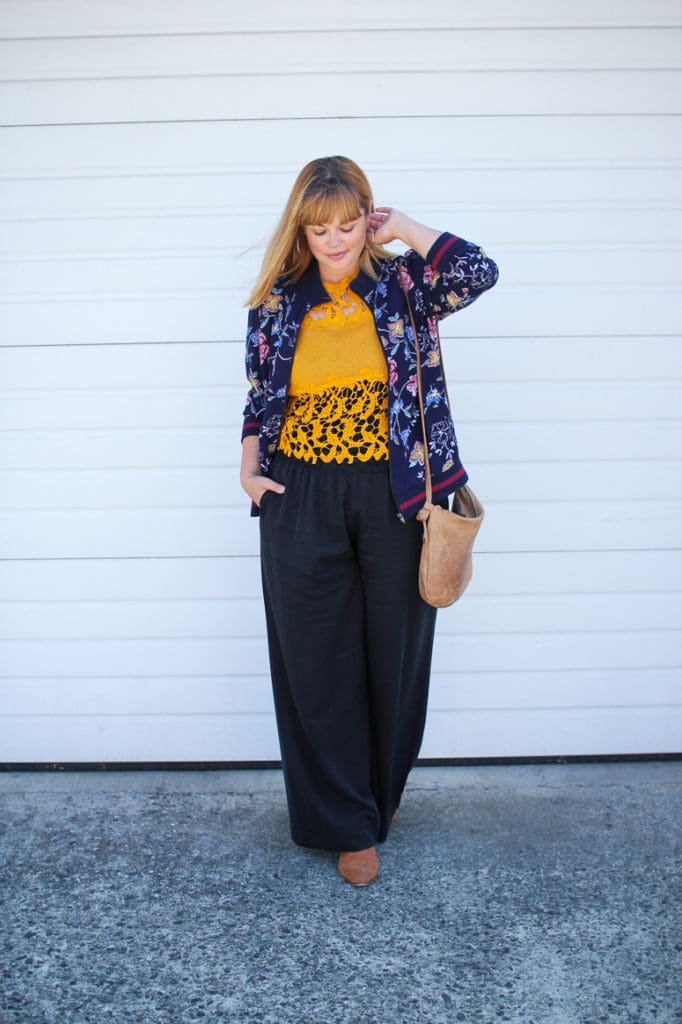
Hi Jen! Please tell us a bit about yourself to start.
My name is Jen Pistor (pronounced Peace-tor, not piss-tor). I am a 42-year-old, size 16-ish, Wife, and Mom of three. I am a slow fashion blogger and stylist. I have a self-titled blog, where I discuss topics under the umbrella of slow fashion: sustainable clothing, ethical fashion, thrifting, secondhand shopping, my self-love journey, size inclusivity, BIPOC owned businesses, and styling and wearing what you have. I have been involved in the fashion industry over the past 32 years. I got my start modelling when I was 10 years old and have worked in many facets of the industry including retail management, visual merchandising, buying styling, fashion writing, entrepreneur, social media management, influencer, and more.
How would you describe your current approach to fashion?
My current approach to fashion is to be a realist. A realist in the sense of being realistic about my lifestyle and what I actually wear. There is a part of me that still wants to dress for my 20/30-something pre-kids days. The days where I went into work and attended many media events that called for dresses, skirts, and a variety of heels. My current reality is being a stay-at-home Mom of three, taking kids to soccer and dance classes, household chores, errands, along with my blog writing and slow fashion styling that is all done from the comfort of my home. Being realistic can help prevent us from buying items that will just hang in our closets, unworn.
What did the journey to get where you are today look like? Any huge “aha” moments along the way?
As someone who has dedicated the past 32 years to working in the fashion industry and getting a diploma in Fashion Merchandising, I have made fashion a very big part of my life. I didn’t see the whole picture though. About five years ago, I watched the documentary The True Cost by Andrew Morgan. The documentary was created after the 2013 Dhaka garment factory collapse in Bangladesh. 1,134 people died in the tragedy and another estimated 2,500 were injured. The documentary highlighted the crimes and immorality of the fashion industry that the privileged, Western world has ignored. This was a pivotal moment for me. Everything changed. I already was trying to make small improvements to my shopping practices, but this documentary had me seeing everything differently. It showed the human suffering that goes into the making our cheap trends. It highlighted the environmental devastation the fashion industry creates. It made me rethink everything. I highly recommend watching it. Once I got past the guilt, I worked on educating myself even more. I sought out articles, statistics, social media accounts dedicated to sustainable and ethical fashion, fashion brands doing things differently, podcasts, and anything else I could find. I started thrifting for myself. I had already been secondhand shopping for my kids, but now it was my turn. I decided to start sharing my sustainable style journey on my blog and through my social media to help keep myself accountable. I have quit fast fashion and transformed the way I shop and found my personal style in the process.
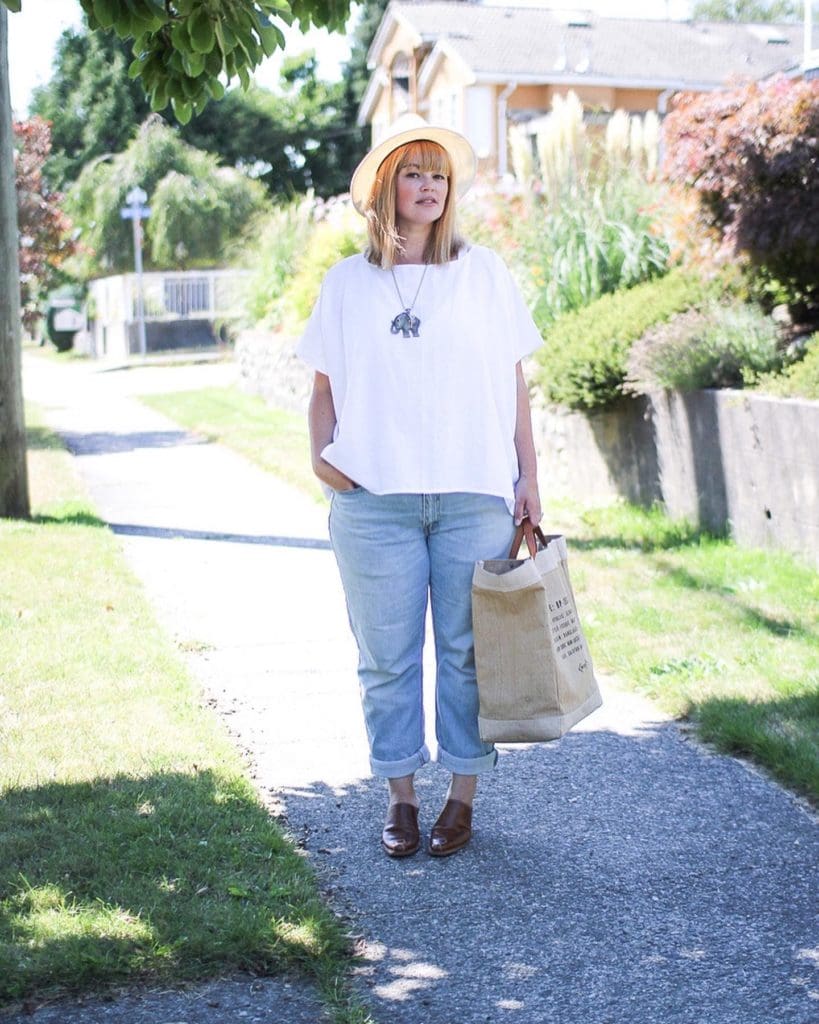
How do you use your platform to impact those who follow you?
I don’t believe that shame brings change. I have seen this tactic and it almost always results in confrontation, not education. Pointing the finger at people will never bring change. I feel like the best way to create change is to be the change you want to see. As cliche as that may sound, showing people my outfits that are put together with old items, thrifted finds, and small, ethical, brands, is the best way to get people to think about their own shopping habits. Yes, I share stats and info I learn along the way, but none of that is to make anyone feel bad, it’s to help people learn and do better once they know better. The ones that need to be held accountable are the big multimillion, scratch that, multibillion-dollar companies that exploit people and the planet. The rest of us need to do our best to shop with our beliefs and values and not be another cog in the capitalist wheel.
Fast fashion is a real buzzword these days; what is the true cost of this type of clothing production/consumption?
Fast fashion is a business model used by mass-market retailers. They rapidly produce trends and runway looks cheaply, at incredible speed, and overproduce inventory. More recently, ultra-fast fashion has emerged on the scene with online retailers responding to Instagram and Tik Tok trends within days. This type of production does not have the impact of people or the planet in mind. Not only is production fast, this model is designed for consumers to purchase fast and often as well. They make it. We buy it. When you’re shopping and see a cute, cotton/polyester top for $15, keep in mind:
- A farmer had to grow that cotton. Soil and water were used to grow it. Harmful, to people and planet, pesticides were used too.
- That polyester is plastic and plastic comes from oil. Many fast fashion brands will claim they use recycled polyester, but research has shown that only a fraction of the polyester they use is actually recycled and the majority is new.
- Someone dyed that fabric. How much water was used? Are those dyes being dumped into local waterways with no treatment?
- A skilled sewer (usually a Woman of Colour), made that garment. Everything we wear is sewn and constructed by someone. How were those garment workers treated? Were they paid a fair and living wage?
- That garment now needs to be prepped, packed, and shipped to different locations around the world. What is the carbon footprint of that top?
- Upon arrival, someone will unpack, hang, and merchandise that garment on the shop’s sales floor.
Does it seem realistic that all this can cost you just $15, all while the retail giant still makes a profit from that garment? The true cost of cheap clothes will always be the exploitation of people and harm to the planet. To quote Fashion Revolution: “People and nature are paying the price of the fashion industry’s unregulated exploitation and waste. Brands are avoiding the realities of climate breakdown by continuing to pursue extractive business models and greenwashing their way to sustainability. In 2022, we need brands to radically reduce their environmental impact by shifting their focus away from growth.”
By contrast, as a content creator, how has being a part of the slow fashion movement provided you with a way to deal with other global issues happening out there?
Once I started to deep dive into all things sustainable/ethical fashion, I soon found out that there is a lot of intersectionality in the subject. At its core, slow fashion is a simple movement. Buy less and wear what you have more. However, there is a lot more at play when it comes to the fashion industry and the challenges that need to be dealt with. Once you start looking into labour practices of fast fashion brands, you run into human rights issues, colonialism, gender inequality, politics, and modern-day slavery. If you are to read up on fabrics and textiles, you will learn about environmental impact, animal and human suffering, and climate change. If you look into the ethics of brands, you’ll find discussion about the lack of size inclusivity + diversity, greenwashing, brands burning and destroying their own products, fat-phobic narratives, and capitalism. According to statista.com, the Global Apparel Market in 2021 was worth 1.5 trillion USD. It’s impossible for and industry that size to not have a massive impact on many different facets of global life. I am constantly learning about these complex topics. Being a part of this community has allowed me to help expose these truths, sign petitions, donate to causes, all while unlearning what I thought I knew.
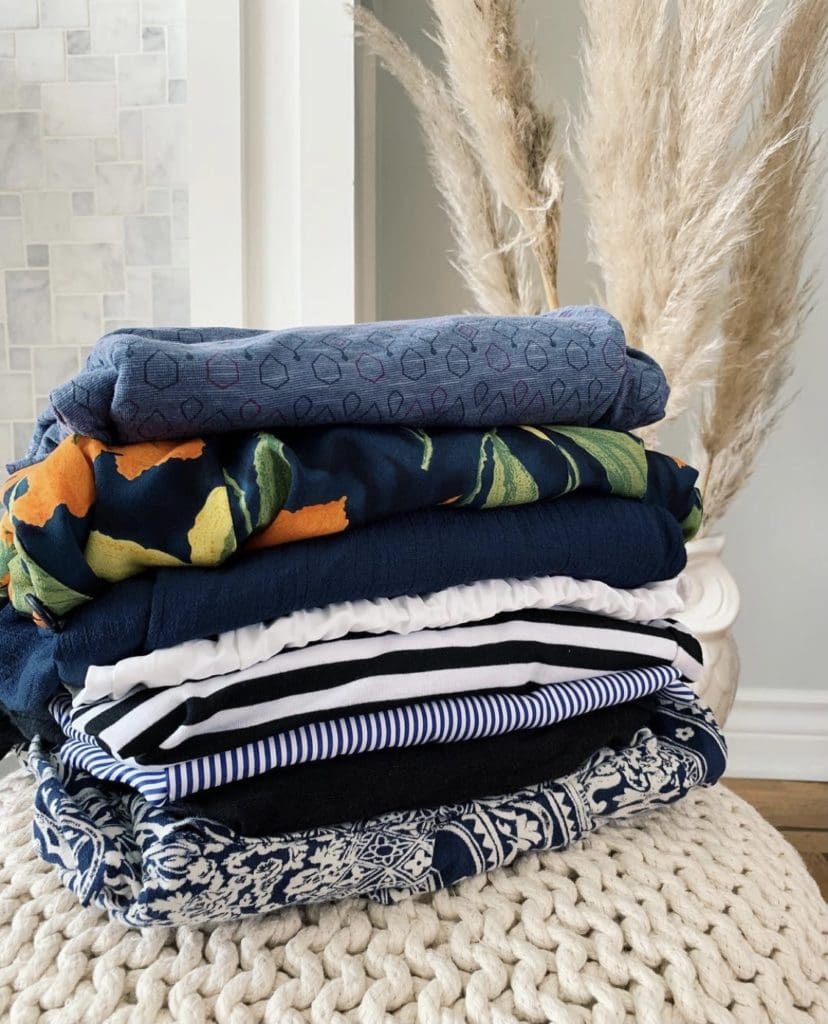
Seems like style trends come in and go out at breakneck speed these days; what’s your best advice for keeping our fashion fresh and sustainable?
Get to know your personal style and embrace it. You can lean into a trend or two, most likely, with items you already own. Since nothing in fashion is new, secondhand shops are a great way to find a trendy piece to incorporate into your existing wardrobe. And, if trends really aren’t your thing, leave them! Trends are a marketing tool. A way for us to be coaxed into buying more. If you don’t need anything, just leave it. I believe our individual, personal style is far more interesting than any trend that may come our way. I don’t know if there has ever been a time where there have been more trends to choose from. The trend lifecycle is much shorter now too. The fashion industry used to have two seasons per year. There were the Spring/Summer Collections, the Fall/Winter collections, and occasionally a resort or holiday collection. Now, due to fast fashion, there are 52 seasons per year. There are dozens of trends, and so much of the information out there is conflicting. So, how do we navigate trends while being more sustainable? Assess your current wardrobe and shop your closet. Determine what you feel good in and gravitate to. Which silhouettes are you feeling right now? What seems like it may be missing? A button up shirt? Some good fitting jeans? A cool duster? Colour? Don’t do all the things. Personally, I’m loving seeing all the colour available this year. Bright, happy hues that has been dubbed as dopamine dressing. I already have some lovely colourful pieces in my closet, so I plan on leaning to those pieces even more this season. I have also managed to pick up a couple of new-to-me secondhand items, that will add some pop to my wardrobe. Stay true to your own style. Trends can be fun, but are often fleeting. If you don’t think you will wear a mesh crop top 30+ times, it’s probably not a sustainable option. If you decide to add in some bright colours to your wardrobe with items in your favourite silhouettes, there is a bigger chance these items will be worn over and over and for years to come.
We know you love a good thrifted find! What are your top tips for secondhand shopping and repairing and/or modernizing thrifted finds?
The biggest thing I learnt about secondhand shopping is to manage my expectations. When I really started getting into thrifting, I had this romanticized notion that I would be scouring the racks, and come across a high end, vintage, designer piece, in my size, that would fit like perfection and be the most cherished item in my wardrobe. That’s not really how it works, especially as a plus sized person. While I have found some amazing pieces, I have also brought home some fast fashion joggers, no name blouses, and homemade sweaters. They might not be coveted by everyone, but I adore them. When it comes to secondhand shopping, there are many ways you can go about it:
- thrift shop
- consignment store
- curated secondhand boutique
- online secondhand apps like Poshmark or Thread-up
- local clothing swaps (either an event style one or one with friends)
When secondhand shopping, I suggest:
- Make a list of what you’re looking for and try to stick to it
- Look often and give yourself time
- Look at more than one size. Sizing can vary so much depending on the era and where the garment was made.
- Shop the mens and women’s department. I love grabbing myself men’s tees and I found a great pair of men’s Levis (since the women’s ones never fit me)
- Don’t rule out fast fashion brands.
- Read those labels and opt for natural fabrics as often as you can
- Don’t be afraid to shorten a hem, tailor a jacket, or switch out buttons. These can be small, relatively inexpensive fixes that can modernize a piece.
- Make sure that item you’ve fallen in love with in the thrift shop is something that will actually work in your wardrobe and that it will be worn many times over.
You often call yourself a maximalist; how do you, then, make the slow-fashion lifestyle, which is often associated with a “less is more” approach, work?
If you were to go back and look in my closet about 10 years ago, you would find about double the garments I currently have. I was absolutely an over-consumer. To me, loving fashion meant having it all. Now, I have a much more paired down version of my previous wardrobe, although, there is still quite a bit hanging in my closet. Many people in the slow fashion space have adopted the concept of a capsule wardrobe. A capsule wardrobe is a smaller collection of clothing you can wear over and over in multiple ways for multiple occasions. Usually it is limited to a specific number of items ranging from 30-50 items, although there are many ways to go about it. When I made the conscious decision to move towards a more sustainable wardrobe, it felt irresponsible to simple toss everything out and start over. After all, the most sustainable wardrobe is the one you already have. So, since I was starting from a place of having a massive wardrobe (I seriously took over an entire room in our home for my closet.), I opted to work with what I had first. I have slowly and mindfully edited my closet over time. I have purchased items both new and secondhand that suit me and my lifestyle. The items I have kept have been worn many times over. The pieces I decided no longer served me have been sold, given to friends and family, or, as a last resort, donated. I call myself a maximalist, as I have not adopted the capsule wardrobe concept. It isn’t for everyone, although I totally see the appeal for some. I am still very aware of my closet inventory. I don’t ever want to go back to a place of having so much I don’t know what I have, wearing things only a couple of times before passing them on, or constantly shopping for new things as feel good purchases. I’ve learnt that I can’t buy my personal style. While I do buy new things from time to time, thought and care go into each buying decision I make.
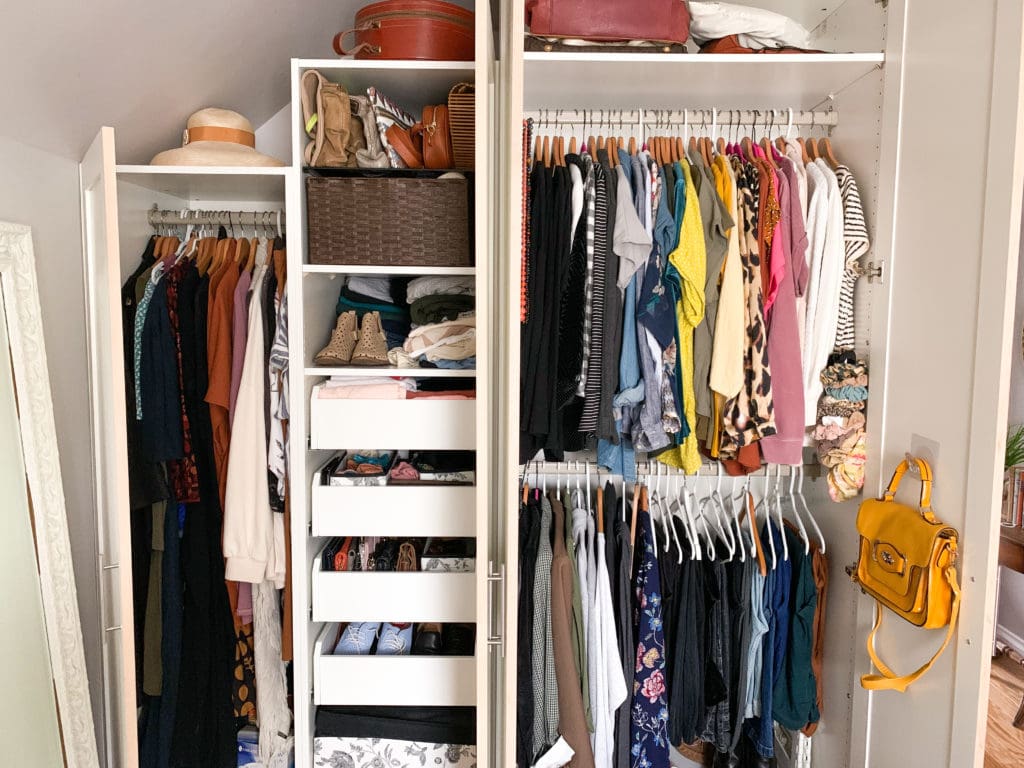
Can you tell us more about your belief that, through loving and respecting our clothing, we can minimize our desire for excessive shopping all while curating a wardrobe that represents who we are, values and all?
“Don’t love your clothes. They are just things.” I have heard this said often when advice is given to living a more minimalist lifestyle. As someone who is more of a maximalist, but not in excess, and also works within a slow fashion mindset, I feel differently. When the rise of fast fashion came in with a vengeance, we lost our appreciation for our clothing. It became disposable. I can still hear my own voice ringing in my ears, “It’s only $10! Even if I just wear it once!” I didn’t appreciate all my clothes. Some I did, but some were completely disposable. Every garment we own came from somewhere, even that $10 tee. I have a much different mindset now. I am thankful for every garment hanging in my closet. I cherish the craftsmanship and expertise of the garment makers who made my clothes. I adore the local designers and small brands who have poured their hearts and souls into each new collection we are graced with. So, do I love my clothes? Yes. I do. And because of this, I wear them again and again. I launder them with care. I mend them when needed. I try to sell or find new homes for pieces that no longer fit or serve me. I try not to buy things on a whim. I believe that through loving and respecting our clothing, we can minimize our desire for excessive shopping all while curating a wardrobe that represents who we are, values and all.
Lockdown and the pandemic made casual (and we mean, super casual!) style a daily thing; we need your best advice on how to make our basics not boring!
Our basics are really the core pieces of our wardrobe that make our style come together. Items like t-shirts, jeans, joggers, and sweaters are the heart and soul of our wardrobes. Basic doesn’t have to mean boring though. When I became a full time stay at home mom, after my twins were born, my life got very casual. Even pre-pandemic, I was at home a lot. Comfort now rules my life, and elevated comfy casual has kind of become my style vibe. I love to take a great fitting pair of joggers and t-shirt, and style them with a pair of brogues, layer on a great cardigan or blazer, and add some texture with a fun scarf, bag, and accessories. Layering is a skill I feel I have mastered. It allows me to keep all the comfort and function in my day-to-day wardrobe, while still feeling polished and put together. Play with different combinations of your core pieces to find your own elevated, basic style.
If you could give three pieces of practical advice (or three places to start) to those of us looking to “do better” when it comes to fashion, what would it be?
- Wear what you have. Edit and do inventory of your wardobe. A little note about wardrobe editing: Edit out items that do not fit, you find uncomfortable, or are completely impractical. If you’re editing something out just because you’re bored or uninspired by an item, consider packing it away for a while, but hang on to it. Sometimes taking a break from an item can help that piece feel shiny and new again at a later time. Don’t purge your closet, just to turn around and purchase a whole bunch of new things. Try having less and wearing it more.
- Take good care of your clothes. Launder them properly. Hang or fold them with care. Mend or repair items when needed. Extending the life of our clothes is definitely a sustainable mindset.
- New items shouldn’t be the go-to. When you are seeking out something, try looking for that item secondhand first. For the times you are needing something specific and new is the best option (often the case for me when looking for pants), seek out a small, local (if possible), sustainable + ethical brand.
We all need to find ways to challenge ourselves with our clothing. An amazing place to start can be by asking yourself two simple questions: who made my clothes? What’s in my clothes? The non-profit organization, Fashion Revolution, has created an annual campaign called Fashion Revolution Week. The event happens every year in the week surrounding April 24th. This date is the anniversary of the 2013 Rana Plaza Collapse in Bangladesh. The week is designed to highlight the the true cost of clothing. It’s a week where we, as individuals, can come together to put focus on the truths around the industry by holding the big players accountable. This year, Fashion Revolution Week is Happening April 18-24. You can visit their website or their Instagram pages @fash_rev and @fash_revcan to see how you can get involved.
Follow Jen on Instagram and read more in-depth conversation around slow fashion and mindful shopping and style on her blog.
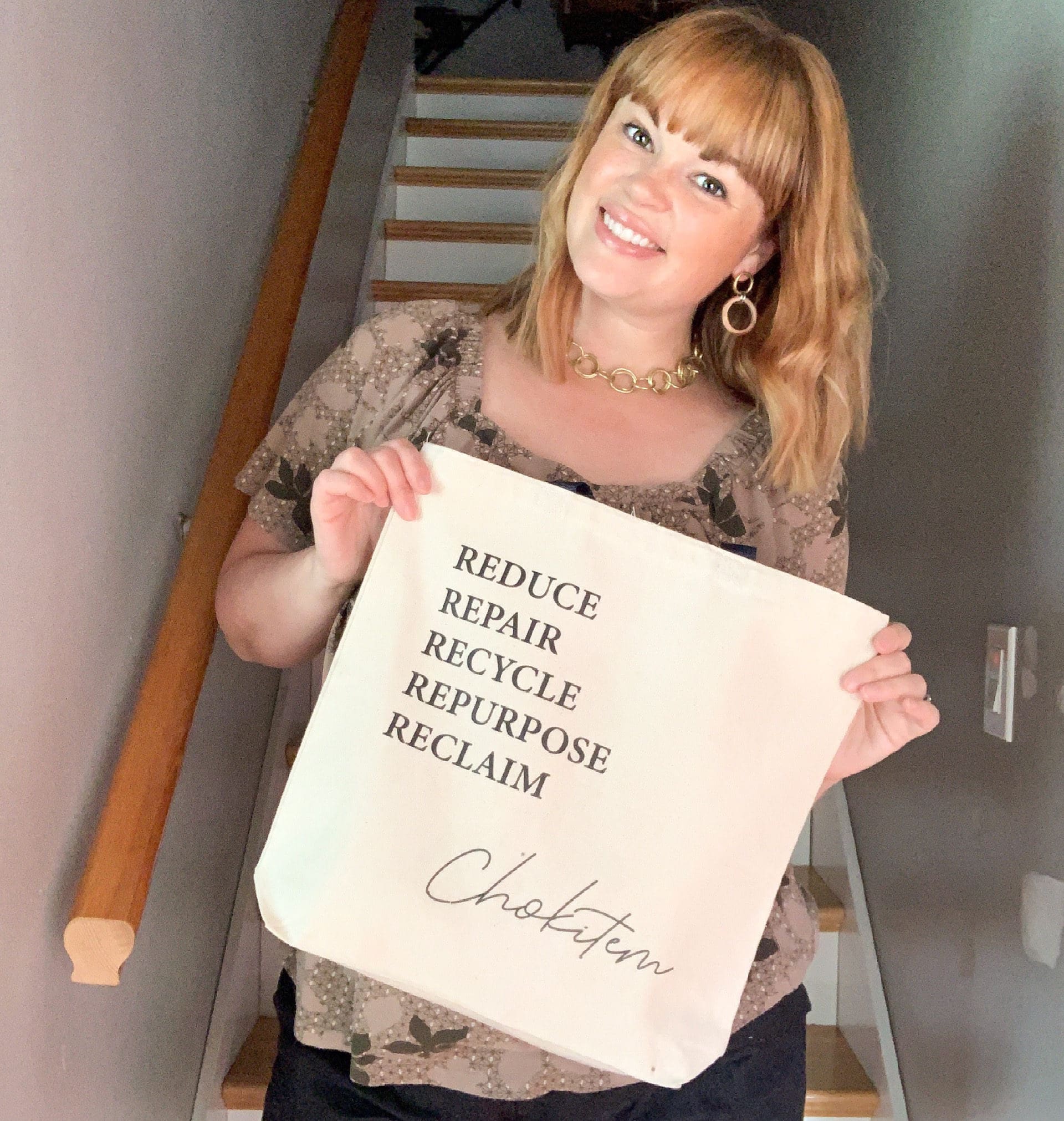
Be the first to comment